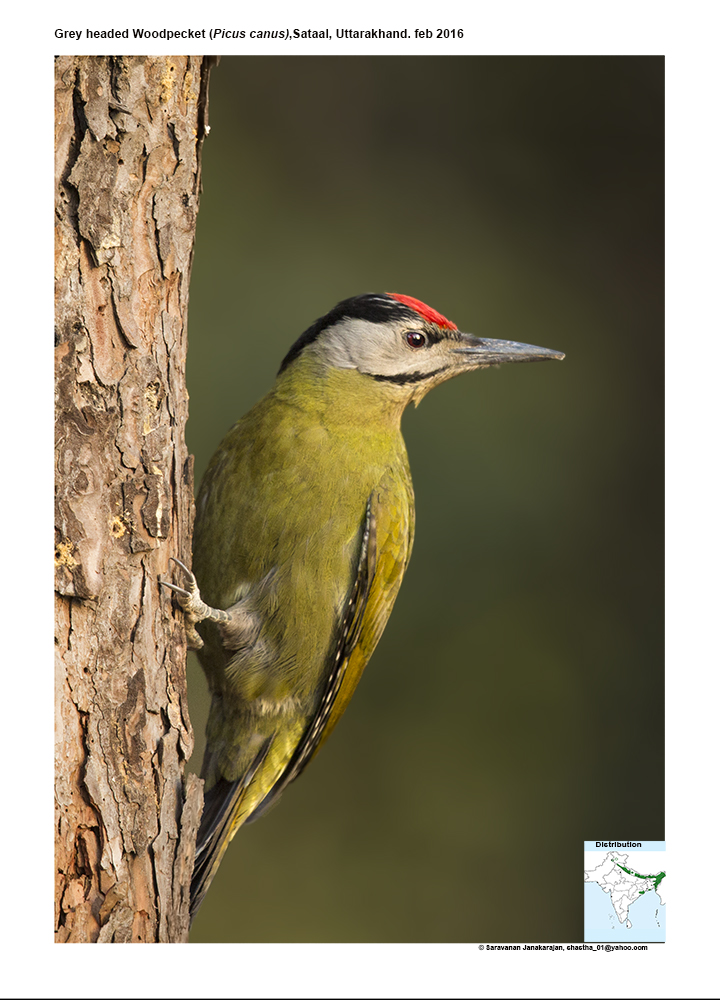Grey-headed Woodpecker

Grey-headed Woodpecker Picus canus
Etymology:
- Picus : Latin word for Woodpecker; Greek Mythology Picus, king of Latium, who married the beautiful nymph and songstress Canens and was changed into a woodpecker by the spiteful Circe, whose affections he had spurned
- Canus : Latin word for Grey
Distribution in India: Resident of Himalayas, East and North East of India.
Description: Size of 28–33 cm; wt. of125–165 g. The male of nominate race has red upper forehead and forecrown yellowish at rear, crown has very fine black streaks, short pale line over eye, narrow black malar stripe often mottled grey at rear; rest of head and neck are ash-grey, slightly tinged greenish when fresh, darker on nape and neck. The chin and throat are pale grey-white, tinged buff or olive. The upperparts are olive-green, rump and uppertail-coverts are yellowish or greenish-yellow, latter with olive-green feather bases, wing-coverts are slight bronze or yellowish tinge. The primaries are greyish-black to brownish-black, small whitish spots on outer webs, sometimes also on some inner webs, secondaries are greyish-black with dull olive-green on outer webs, outer feathers are often with paler spots. The uppertail is greenish-brown and has obscure paler bars; pale grey below, lower flanks and belly with slight tinge of pale olive-green when fresh, occasionally obscure darker chevrons on lowermost underparts. The underwing is greyish and heavily barred; undertail is blackish, tipped greenish-grey and has a few obscure paler bars. It has a fairly long broad-based bill, slightly chisel-tipped, culmen is moderately curved, blackish-brown to grey-black, usually with olive tinge. The iris is pinkish to bluish-white, or deep carmine-red with admixed white; legs are olive-grey to yellowish-olive. The female on average is slightly smaller than male, proportionately shorter bill, head lacking red, has forehead and forecrown pale grey with narrow black shaft streaks, occasionally a few scattered red tips on forehead, black malar is weaker and often incomplete. The juvenile is duller than adult, greyer above with slight scaly appearance, rump is more greenish, some indistinct bars on wing, malar is more diffuse and mottled, inconspicuous darker barring below, eyes are red-brown, male has small orange-red crown patch.
Habitat: It is found in open country, in not over-dense forest, floodplain-forest, parks, orchards, gardens, deciduous trees. It is found in lowlands up to 2000 m
Food habits: It eats ants, termites and their brood, Coleoptera larvae, spiders, nest contents of other birds, fruits ,berries, seeds, nuts and acorns and nectar. .It is solitary outside breeding season, else in pairs or small family parties. It regularly feeds on ground; probes into soil, pushing and digging with the bill, using the tongue to lick up prey. It digs funnel-shaped holes that are used repeatedly as sources of ants. It does arboreal foraging with single pecks, some excavation in decaying wood at low levels, and intensive use of the tongue at crevices and sites of decayed wood. It also licks from sap wells. It moves on ground with heavy hops.
Breeding habits: They breed in Apr to Jun in India. The courtship display includes landing with fluttering wing beats associated with presence of partner and a nest-hole and occasional courtship feeding by male. The nest-hole is excavated in 9–20 in dead wood or soft living wood, or in fungus-afflicted hard wood, most often in deciduous tree of variety of species with a vertical oval entrance hole. They lay a clutch of 4–10 eggs. Both the sexes incubate. The male incubates during night and also seems to incubate more than female during day. The incubation period is 14–17 days. The chicks are fed by regurgitation, by both parents equally. The fledging period is 23–27 days. The young will be accompanied by parents for some time afterwards.